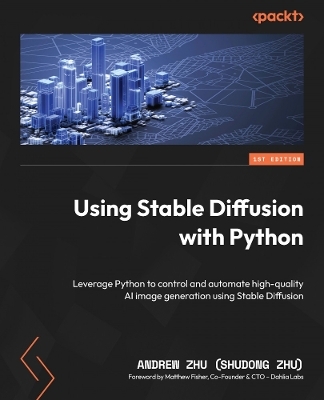
Using Stable Diffusion with Python
Packt Publishing Limited (Verlag)
978-1-83508-637-7 (ISBN)
Key Features
Master the art of generating stunning AI artwork with the help of expert guidance and ready-to-run Python code
Get instant access to emerging extensions and open-source models
Leverage the power of community-shared models and LoRA to produce high-quality images that captivate audiences
Purchase of the print or Kindle book includes a free PDF eBook
Book DescriptionStable Diffusion is a game-changing AI tool that enables you to create stunning images with code. The author, a seasoned Microsoft applied data scientist and contributor to the Hugging Face Diffusers library, leverages his 15+ years of experience to help you master Stable Diffusion by understanding the underlying concepts and techniques.
You’ll be introduced to Stable Diffusion, grasp the theory behind diffusion models, set up your environment, and generate your first image using diffusers. You'll optimize performance, leverage custom models, and integrate community-shared resources like LoRAs, textual inversion, and ControlNet to enhance your creations. Covering techniques such as face restoration, image upscaling, and image restoration, you’ll focus on unlocking prompt limitations, scheduled prompt parsing, and weighted prompts to create a fully customized and industry-level Stable Diffusion app. This book also looks into real-world applications in medical imaging, remote sensing, and photo enhancement. Finally, you'll gain insights into extracting generation data, ensuring data persistence, and leveraging AI models like BLIP for image description extraction.
By the end of this book, you'll be able to use Python to generate and edit images and leverage solutions to build Stable Diffusion apps for your business and users.What you will learn
Explore core concepts and applications of Stable Diffusion and set up your environment for success
Refine performance, manage VRAM usage, and leverage community-driven resources like LoRAs and textual inversion
Harness the power of ControlNet, IP-Adapter, and other methodologies to generate images with unprecedented control and quality
Explore developments in Stable Diffusion such as video generation using AnimateDiff
Write effective prompts and leverage LLMs to automate the process
Discover how to train a Stable Diffusion LoRA from scratch
Who this book is forIf you're looking to gain control over AI image generation, particularly through the diffusion model, this book is for you. Moreover, data scientists, ML engineers, researchers, and Python application developers seeking to create AI image generation applications based on the Stable Diffusion framework can benefit from the insights provided in the book.
Andrew Zhu is an experienced Microsoft Applied Data Scientist with over 15 years of experience in the tech field. He is a highly regarded writer known for his ability to explain complex concepts in machine learning and AI in an engaging and informative manner. Andrew frequently contributes articles to Toward Data Science and other prominent tech publishers. He has authored the book "Microsoft Workflow Foundation 4.0 Cookbook," which has received a 4.5-star review. Andrew has a strong command of programming languages such as C/C++, Java, C#, and Javascript, with his current focus primarily on Python. With a passion for AI and Automation, Andrew resides in WA, US, with his family, which includes two boys.
Table of Contents
Introducing Stable Diffusion
Setting Up the Environment for Stable Diffusion
Generating Images Using Stable Diffusion
Understanding the Theory Behind Diffusion Models
Understanding How Stable Diffusion Works
Using Stable Diffusion Models
Optimizing Performance and VRAM Usage
Using Community-Shared LoRAs
Using Textual Inversion
Overcoming 77-Token Limitations and Enabling Prompt Weighting
Image Restore and Super-Resolution
Scheduled Prompt Parsing
Generating Images with ControlNet
Generating Video Using Stable Diffusion
Generating Image Descriptions using BLIP-2 and LLaVA
Exploring Stable Diffusion XL
Building Optimized Prompts for Stable Diffusion
Applications - Object Editing and Style Transferring
Generation Data Persistence
Creating Interactive User Interfaces
Diffusion Model Transfer Learning
Exploring Beyond Stable Diffusion
| Erscheinungsdatum | 03.11.2023 |
|---|---|
| Vorwort | Matthew Fisher |
| Verlagsort | Birmingham |
| Sprache | englisch |
| Maße | 191 x 235 mm |
| Themenwelt | Mathematik / Informatik ► Informatik ► Programmiersprachen / -werkzeuge |
| Informatik ► Theorie / Studium ► Künstliche Intelligenz / Robotik | |
| Technik | |
| ISBN-10 | 1-83508-637-3 / 1835086373 |
| ISBN-13 | 978-1-83508-637-7 / 9781835086377 |
| Zustand | Neuware |
| Informationen gemäß Produktsicherheitsverordnung (GPSR) | |
| Haben Sie eine Frage zum Produkt? |
aus dem Bereich


